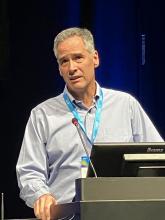New Follow-Up Data Support DMOAD Activity
Yet, additional extension data from the phase 3 lorecivivint trial presented in the EULAR DMOAD session challenge the conclusion even if they do not change the results.
The new data presented at EULAR is the second of two sets of extension data. The first, reported earlier, involved an analysis at 96 weeks or 48 weeks after the double-blind trial. At the beginning of this extension, lorecivivint-start patients had received a second intraarticular injection of 0.07 mg, while placebo patients were crossed over to receive their first injection.
Over the course of this first extension, the gradual loss in medial JSW observed from baseline to the end of the initial 48 weeks had plateaued in those treated with lorecivivint, but the decline continued in the placebo group. As a result, the lorecivivint-start patients had a numerical but not a statistically significant advantage for medial JSW over the placebo-switch group, according to Yusuf Yazici, MD, chief medical officer of Biosplice Therapeutics, San Diego, which developed lorecivivint.
In a second open-label extension described by Dr. Yazici at EULAR 2024, a third injection was administered to the lorecivivint-start patients and a second injection to the placebo-start patients. After 52 more weeks of follow-up, there were now 3 years of follow-up in the lorecivivint-start group and 2 years of follow-up in the placebo-start group.
At the end of this second extension, lorecivivint-start patients had a median increase in JSW that was approaching the baseline level at study entry. Although the placebo-start group had experienced a decline in the medial JSW at the end of the first extension when they had received one injection, JSW had also improved in the direction of baseline after a second injection with 2 years of follow-up. The advantage of three injections of lorecivivint over 3 years had now reached statistical significance (P = .031) despite the improvement seen in the placebo-start group following two injections over 2 years.
At 3 Years, Benefit Is Finally Potentially Significant
If placebo-treated patients had not received a second shot of lorecivivint and progressed at the rate seen before their second shot, the hypothetical trajectory would have provided lorecivivint with a highly statistically significant advantage (P < .001), said Dr. Yazici, displaying a hypothetical graph.
Along with improvements in pain and function associated with lorecivivint relative to placebo at 6 months, 12 months, and 24 months, the structural improvements in 3 years now suggest that “long-term treatment with lorecivivint has the potential to be a DMOAD for knee OA,” Dr. Yazici said.
While Dr. Berenbaum did not comment on this speculation, he did note the potential need for long-term studies to prove a disease-modifying effect in OA. This is the rationale for identifying surrogates.
To illustrate this point, Dr. Berenbaum made an analogy between OA and cardiovascular disease. In cardiovascular disease, surrogates of disease-modifying therapies, such as control of hypertension or hyperlipidemia, are accepted by regulatory agencies on the basis of their proven association with hard endpoints, such as myocardial infarction, stroke, or cardiovascular death. Like joint failure, these events can take years or decades to arise.
“For trials in OA, we need to agree on these surrogates,” Dr. Berenbaum said, although he acknowledged that they would then have to be validated. Noting that the US Food and Drug Administration has now identified OA as a serious disease for which accelerated drug approvals will be considered to address an unmet need, Dr. Berenbaum suggested there is an even greater impetus for improving strategies for DMOAD development.
Dr. Berenbaum reported financial relationships with Grünenthal, GlaxoSmithKline, Eli Lilly, Novartis, Pfizer, and Servier. Dr. Conaghan reported financial relationships with AbbVie, AstraZeneca, Eli Lilly, Galapagos, GlaxoSmithKline, Grünenthal, Janssen, Levicept, Merck, Novartis, Pfizer, Regeneron, Stryker, and UCB. Dr. Yazici is an employee of Biosplice Therapeutics, which provided funding for the OAS-07 trial.
A version of this article first appeared on Medscape.com.

